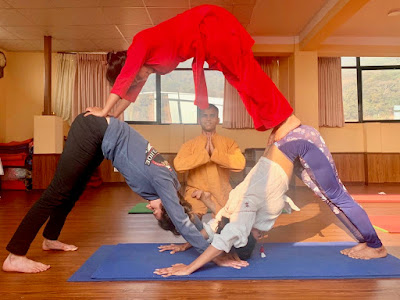My true purpose in Nepal was to study yoga, to which I dedicate this post. Himalayan Yoga Academy uses a holistic and authentic approach to teach ashtanga yoga. It also serves as a retreat sanctuary, offering various spa and healing therapies (ie., massage, oil, reiki, singing bowls). Located outside central Katmandu’s pollution, the beautiful new facility is surrounded by Nagarjun jungle; the background hum includes morning roosters and soaring hawks, distant chanting, children playing, dogs barking, and cars honking. Dr. Subodh, master of yoga and reiki (energy healing), founded the academy in 2007. His wife and three children create a family-oriented atmosphere.






The 200-hour YTT is a rigorous 26-day program. Dr. Subodh—the guru—was our main guide. Other instructors included Ramhari and Erika. Close family friend and neighbor, Erika’s recent devotion to yoga has supported her spiritual journey in her shift from film to social work. According to the guru, the YTT schedule is not truly ethical, as yoga instructors typically study for at least a year. However, the course aims to train students with a basic understanding of teaching others; those serious about instructing can subsequently complete a 300-hour advanced training. Nevertheless, I attempted to stay focused and absorb as much as possible.
Yogi Schedule
6:30a - 7:00a: nasal cleansing, herbal tea
7:00a - 9:00a: warm-up exercises, sun salutation
9:00a - 10:00a: breakfast, herbal tea
10:00a - 11:00a: break/study
11:00a - 1:00p: theory session
1:00p - 2:00p: lunch, herbal tea
2:00p - 3:30p: break/study
3:30p - 5:00p: practical session
5:00p - 5:30p: herbal tea
5:30p - 7:00p: meditation
7:00p - 8:00p: dinner, herbal tea
8:00p - 9:00p: discussion, concentrated gaze
Almost immediately, I recognized that traditional eastern yoga poses a stark contrast to the western-style approach that I was accustomed to. I would like to take this opportunity to share the major take-aways. Yoga began thousands of years ago in the Indian/Himalayan belt. Though this was before religion developed, the Hindu god, Shiva, was said to be the first yogi and guru. He passed his knowledge onto seven sages, one of which, Maharshi Patanjali, documented the ancient knowledge in the first yogic text—Yoga Sutras. The ancient Sanskrit language shares an alphabet with Hindi and Nepali. The English translation of the Sanskrit word yoga means "union." Thus, yoga has become a means to prepare and unite the body and mind for the ultimate goal of meditation (ie., self-realization) by awakening the Kundalini energy centers (chakras). Over the years, yoga philosophy has spread and transformed. Patanjali’s work described that of astanga yoga, which is inclusive of all types. The eight-fold path combines external (hatha) and internal (raja) yoga. Regarding the physical aspect of the practice, hatha yoga is a disciplined approach that focuses on flexibility and strength vs. cardiovascular endurance; ethically, yoga increases energy whereas aerobic exercise decreases it. The practice is usually structured as follows: chanting prayers (mantras), subtle and dynamic warm-up exercises, static postures (asanas), breathing exercises (pranyama), meditation (dhyana).




After the first few days of training, every muscle in my body felt sore. This feeling continued throughout the month as my joints opened and body strengthened. The guru’s wife, Kopila (or "Mami Ji"), kept us fueled with fresh, colorful plant-based dishes; oatmeal and seasonal fruit for breakfast, dal bhat tarkari (rice, lentils and curried vegetables) and saag (leafy greens) for lunch, and rotating plates for dinner—often stir-fried rice/noodles, momos (dumplings) or various types of roti (flour tortilla). And of course, herbal tea throughout the day; ginger tea with honey was my favorite!








Not only was my physical body challenged during the program, but my mind also. I strived to be open to change, new experiences and a relative lack of control/freedom given the nature of the YTT. Still, much of my discomfort stemmed from cultural nuances. At home, for example, I am used to a specific standard of communication, instruction/guidance and professionalism. My experience in Nepal, in contrast, contained relatively less communication with an underlying disorganization. I almost never knew what was going on until it was already happening. This pushed me to be present, patient and flexible.
The immersion was intensified by the fact that Samjhana and I were the only students in the program (i.e., low season and coronavrius qualms). A sweet, young woman from west Nepal, Samjhana shared my interest in lifestyle medicine. Though I valued her companionship as we helped each other learn our native languages, I imagined at least a few other international students in the class. Fortunately, however, foreign guests periodically passed through the academy for varying lengths of time, which offered a sense of familiarity and connection. These friendships included Mike from New York, Kathi and Geoff from Canada, and Fabienne from Switzerland.
 |
| A special send off for Mike, Kathi and Geoff |
Sanskrit:
ॐ भूर् भुवः स्वः
तत् सवितुर्वरेण्यं
भर्गो देवस्य धीमहि
धियो यो नः प्रचोदयात्
तत् सवितुर्वरेण्यं
भर्गो देवस्य धीमहि
धियो यो नः प्रचोदयात्
English translation:








